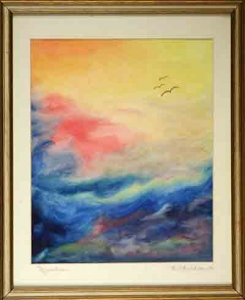Migration (Luctman)
M1999.010.014
c. early 20th century
This water color depicts birds in flight. As a reflection of the time, birds and flight were a wonder. Since humans had not yet discovered flight, the effortless gliding of these creatures must have been a source for imagination. One way that this came out was through atristic depictions that were simply the opposite of what this piece shows. It is an effort to answer the question, what would we look like to the birds?
“Known as bird’s-eye views, panoramas or perspective maps, detailed illustrations were very popular with inhabitants of proud and growing communities during the latter half of the 19th century. Itinerant artists would walk the streets of a town and make sketches of its buildings. They were then assembled into a single drawing depicting the town’s streets, houses and businesses, showing the community as if seen from above, hence the name “bird’s-eye view.”
Once completed by the artist, the view of the city was printed and sold to local people who took pride in the representation of their home town in all its individuality. Since the primary market for the view was the residents themselves, accuracy was important; street names had to be right and buildings correctly portrayed. Because people expected their city or village to be depicted as thriving and prosperous, the artist added details like smoke streaming from factory chimneys, ships sailing the rivers or harbors, and railroad engines busily hauling freight. Some views show their subject in great detail, even down to the number and placement of the doors and windows in individual houses. Such views can be valuable resources for local history and architectural research. Even if not completely accurate, all bird’s eyes provide a uniquely American vision of the urban landscape.” – Wisconsin Historical Society.

